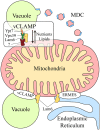Interorganelle Communication between Mitochondria and the Endolysosomal System
- PMID: 29164114
- PMCID: PMC5681906
- DOI: 10.3389/fcell.2017.00095
Interorganelle Communication between Mitochondria and the Endolysosomal System
Abstract
The function of mitochondria and lysosomes has classically been studied separately. However, evidence has now emerged of intense crosstalk between these two organelles, such that the activity or stress status of one organelle may affect the other. Direct physical contacts between mitochondria and the endolysosomal compartment have been reported as a rapid means of interorganelle communication, mediating lipid or other metabolite exchange. Moreover, mitochondrial derived vesicles can traffic obsolete mitochondrial proteins into the endolysosomal system for their degradation or secretion to the extracellular milieu as exosomes, representing an additional mitochondrial quality control mechanism that connects mitochondria and lysosomes independently of autophagosome formation. Here, we present what is currently known about the functional and physical communication between mitochondria and lysosomes or lysosome-related organelles, and their role in sustaining cellular homeostasis.
Keywords: aging; autophagy; exosomes; lysosome; proteostasis; quality control.
Figures


References
Publication types
LinkOut - more resources
Full Text Sources
Other Literature Sources

